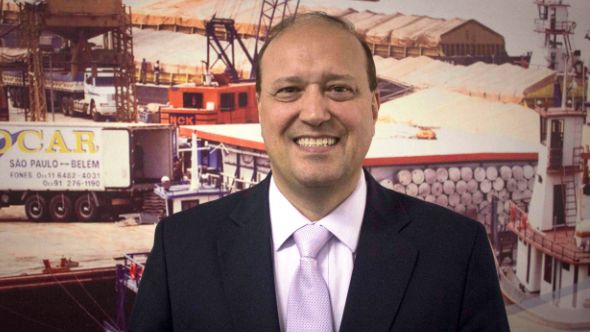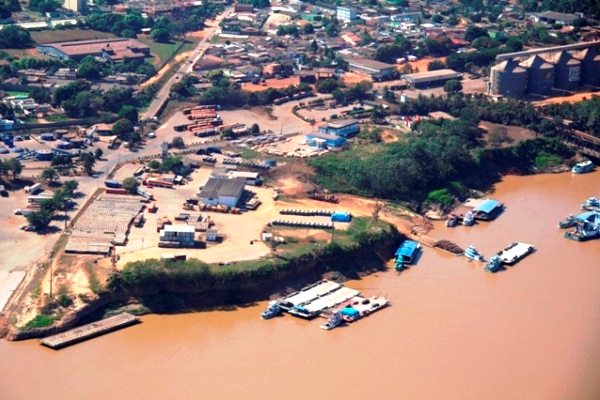Port of Porto Velho: Rondônia’s Society of Ports and Waterways
Ricardo de Sá Vieira, from Rondônia’s Society of Ports and Waterways, explains the role of SOPH and mentions some of the characteristics of the port of Porto Velho. He also discusses investment projects and opportunities.
Interview with Ricardo de Sá Vieira, President of Rondônia’s Society of Ports and Waterways (SOPH)

Let’s start with a brief presentation of SOPH. What is the role of the society?
One of our investment projects is the beginning of the operations of cotton export. This cotton comes from Mato Grosso that produces 900,000 tons each year. Until today all this cotton has been exported through the Santos and Paranaguá harbors and, with the beginning of these operations, we are going to be able to relieve these harbors.
Rondônia’s Society of Ports and Waterways began operating in 1904/1905. A railroad was built in order to get rubber from Bolivia and other cities in Rondônia and deliver it in Porto Velho. Large US ships bringing material for the construction of the railroad came to Porto Velho near Porto Madeira (Madeira harbor) to load that rubber to be used in the Henry Ford car industry. These two aspects are interconnected: the harbor activity in Rondônia and the rubber export cycle.
The SOPH has existed as a company with legal status since 1997 when the Brazilian government shut down the public federal company called Portobras which was responsible for all harbors in Brazil and passed the organization of the Porto Velho harbor to Docas do Pará. After a while Rondônia claimed the management of the harbor because there is a regional and economic interest in the good management of this harbor and in the development of its activities.
The purpose of the company is to manage all harbor activities of pilotage and mooring of vessels transporting goods (exports and imports). Rondônia exports to America, Europe, Asia and the Middle East.
The navigation in Rondônia is different: our exports through the Amazon are made in barges (flat rafts). These barges transport merchandise mainly to Itacoatiara, Manaus and Santarem cities and a small portion to other harbors in the Amazon. In Itacoatiara and Santarem bulk merchandizes (soybean and corn) are transferred into deep-sea vessels (45 or 75 thousand tons vessels). Merchandises shipped in containers are loaded in Manaus into short sea ships and transferred into deep-sea vessels in the Panama Canal to go to destinations like Asia, Europe, America etc. It is all done according to the destination that the export company wants to give to its merchandise.
Could you present the characteristics of the harbor?
Our organized harbor of Porto Velho is strategically located in the middle of Central America. It’s easy for us to transport products out of Rondônia and Mato Grosso’s northwest into Asia, Europe and America.
Our harbor is characterized by a huge movement of dry bulk products (soya, corn and other grains). We also have some harbor operations in terms of ore, wood, sugar, wheat flour, and all the other commodities. However, we have received a lot of special merchandise (and will continue receiving them throughout the next two years) destined mainly to the projects of the hydroelectric power plants in Santo Antônio and Jirau which are being built here in Porto Velho – we receive here transformers of more than 200 tons.
We also work frequently with the transport of vehicles and food to Manaus (a large consumer center implying a huge transport volume).
We have here a port-backup structure to store cargo and all types of containers. Our tonnage in terms of exports and imports is growing every year: in 2011 our export statistics equaled to 2.3 million tons and in 2012 we reached 3 million exported tons.
Which would be the greatest challenges that the harbor is facing?
Brazil didn’t invest in this area for quite a while but since the government of Confúcio Moura there have been investments made in our harbor management and today we have more than doubled our infrastructures.
Our greatest challenge is the modernization of our equipment, but we already have confirmed resources in Brasília in the Secretaria Especial de Portos da Presidência da República (Harbors Special Secretariat of the Presidency of the Republic) of around 30 million Brazilian Reals to buy equipment, for example a new crane with a capacity of 70 tons, a smaller crane with a capacity of 20 tons, equipment to move ramps, skids, trucks, etc. In the second half of this year at the latest we’ll have a part of our harbor equipment modernized so that it will allow us to increase the operational capacity of the harbor by 50 to 75 %.

We have also entered in the Secretaria Especial de Portos a project to build a new harbor in Porto Velho to export and import liquid bulk (fuel), to store and transport dry bulk (soya beans, corn and others), to store and export cotton and other products, with new roll-on / roll-off ramps.
Our region is specialized in agribusiness (beans, plantation and livestock) and that is our main focus: the management of these agribusiness products.
One of the major projects we expect to be completed within this year is the dredging of specific locations that have created some obstacles to the Madeira river navigation, and the signalization of the waterway to make navigation even safer.
What about investments?
One of our investment projects to be made in the medium to long run is the beginning of the operations of cotton export. This cotton comes from Mato Grosso (a neighbor state) that produces 900,000 tons each year. Until today all this cotton has been exported through the Santos and Paranaguá harbors and, with the beginning of these operations here in Porto Velho, we are going to be able to relieve the Santos and Paranaguá harbors. This will also reduce the transport costs because the road freight straight to the waterway would be only 1,000km. There is an investment opportunity for shipping companies that want to come into our state to perform international logistics operations of this cotton commodity transportation.
We are also interested to plan in the next few years a more intense ore transportation. We have been keeping in touch with CSP (Companhia Siderúrgica do Pecém – Pecém Steel Company), so that they come and make the studies with the Companhia de Minérios de Rondônia (Rondônia Ore Company) concerning the ore products we can export out of Rondônia. This is also a great opportunity for those who want to invest in the north region of Brazil and in the west Amazon (especially Rondônia).
In the short run we have a project to export meat from Rondônia and from the northeast Mato Grosso. We have contacted three major companies (JBS, Minerva and Frigon) and we are sure that around 300 containers per month will leave our harbor. We can reach 500 to 1000 containers if there is a growth in meat importers. What is really important for us is the reduction of the freight costs due to the shorter road transport until our harbor.
Could you describe the state for foreign investors? Why should they choose Rondônia to invest?
Rondônia is in the center of Latin America. Its location is ideal for logistics and transportation of merchandise.
We have soya production and cotton production in our neighbor state. Our state is developing fast reaching percentages of 7.5 (almost the growth seen in China). Our economy is also consolidating.
We are very well located for investors in the ore sector and the logistics and transportation of such cargos, for those who wish to invest in industrialization like soya crushing, vehicle assembly companies etc. There are several tax incentives for companies that wish to come into Porto Velho and all Rondônia.
We have qualified workers and those that aren’t can be qualified by the companies that want to settle here. Our people are very hard working and it’s because of them that Rondônia has been growing at this rate.
What are the opportunities for international investors?
The existing opportunity is to use the logistics. We also have a new Pacific route being prepared: you can go from Porto Velho to Peru by road and then to the Pacific by vessel, taking 28 days less it would normally take and saving thousands of dollars (compared to the Panama route). This is a project to be completed in close future, dedicated mainly to exports.
Are there any other projects for the long run you want to comment about?
Yes, we have a dream and it was already discussed in Brasília: the construction of the Mercosul waterway. We want to build an artificial channel with 50km of navigation possibility connecting the Amazon basin to the Prata basin. This is a project that is already being discussed in Brasília and I hope it comes true in the long run. If China built an artificial waterway with 1,000km, it can’t be that difficult for us to build 50km.